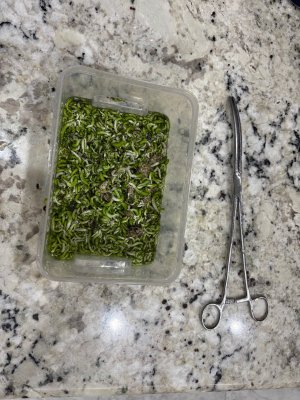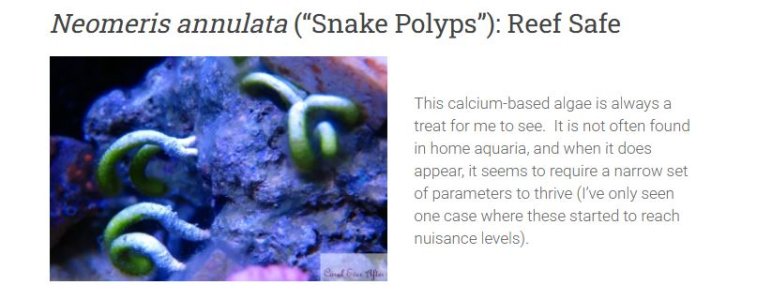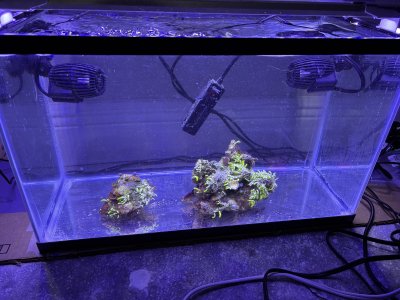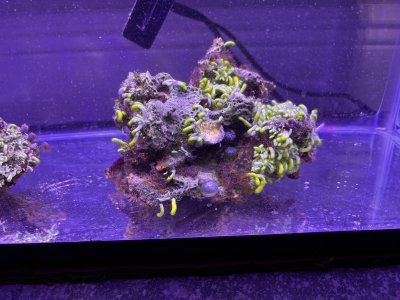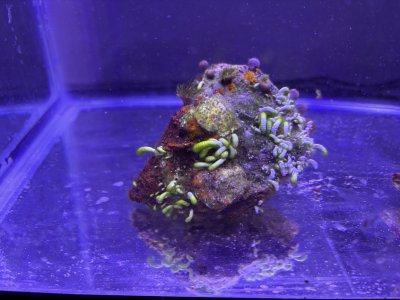Not sure if I am winning or losing the battle. They are still growing but seem to be growing slower. Those that are high in tank in areas of over 250 PAR seem to be struggling to grow staying small and white while ones lower in tank or in shadowed areas seem to be growing faster and have green tips. The urchins seem to be doing nothing, I can' even find them day or night. I'm wondering if they died for some reason after a few days. I don't believe there has been much spread of them just re-growth in same areas. I guess I'll keep up the pruning every two weeks for a few hours and see what happens. I probably need to start back to feeding heavier to get phosphate up to see if that helps, right now I'm only .006ppm.
You are using an out of date browser. It may not display this or other websites correctly.
You should upgrade or use an alternative browser.
You should upgrade or use an alternative browser.
ID Please and Suggestions to Eliminate
- Thread starter hilde123
- Start date
shred5
Premium Member
Not sure urchins will do much with this type of algae unless mowed down FIRST. It is a calcareous algae like Halimeda. So little will eat it. Urchins will eat pretty much anything in their path though including the glue on the sides of aquariums so it might help some..
Funny thing is this algae is really hard for most people to even grow and when you can it is usually considered a sign of a healthy tank.
I used to grow it and people begged for some of it. I liked it and just looked at it as another cool thing growing in my tank. I always liked this stuff and halimeda in a reef aquarium because they are natural on a reef..
It grew in spots but never really took over.
The biggest issue with it is the amount of calcuim and alk it can eat up.
This is a really old picture but if you look in this picture you can see some in the back ground.

Funny thing is this algae is really hard for most people to even grow and when you can it is usually considered a sign of a healthy tank.
I used to grow it and people begged for some of it. I liked it and just looked at it as another cool thing growing in my tank. I always liked this stuff and halimeda in a reef aquarium because they are natural on a reef..
It grew in spots but never really took over.
The biggest issue with it is the amount of calcuim and alk it can eat up.
This is a really old picture but if you look in this picture you can see some in the back ground.
Last edited:
May be too early to tell but I haven't seem any improvement since adding the additional tuxedo urchins. It is still growing faster than it is being consumed. Its been about 2.5 weeks since my last pruning and all the same locations seem to be growing back to lengths varying from .25" to .75" in length. Seems those in high light areas grow much slower. A friend of mine suggested a sea hare. I couldn't find any specific info on whether they will consume neomeris but I did find one place that sold them and said not compatible with macroalgae, I guess thats a good indication but not sure about calcareous algae. Anyone have any insight on likelihood of sea hare eating this stuff?
I can't describe how much I had this darn stuff; it is literally the most frustrating nuisance algae I have EVER come across. I spent three hours today picking and here's what i got, , probably harvested about 3-4 cups worth. I'd say I probably got 80-90% of it but I know in about 1-2 months I'll be back to the same think and probably a bit worse. I'm not sure if the urchins are doing much I think I may go back to heavy feeding as that seemed to slow it down. Does anyone think a sea hare may eat this stuff? I know they can mow down some hair algae real quick!
Attachments
This Neomeris must be very uncommon as spending an hour or better researching comes up with very little information. From the research papers I was able to find it is a calcifying algae but not near a "tough" as Halimeda. The research paper I found indicated that the Dolabella Sea Hare was deterred from Halimeda but when ground up it was consumed by the sea hare without any preference between it and the softer forms of macroalgae. This was evidence that the chemical defenses of the Halimeda did not adversely affect the sea hare. The Neomeris is not not very tough which may help increase odds that sea hare will consume and given that I have no GHA it will likely be inclined to consume the Neomeris even if not its preferred diet. I do have a refugium that is full of different types of algae that I'm sure the sea hare woudl love to feast on so I may try to rotate between refugium and DT if it does seem to consume the Neomeris readily.
In my research I also found a hobbyist that claimed that a Flame Anglefish readily consumed the Neomeris, especially where it had been removed and there were small portions left which may help control if it is able to remove anchor points better than manually pulling can.
Any thoughts on Flame Angel or further thoughts on Dolabella Sea Hare? I've always stayed away from Flame Angels as I have LPS and Clams that I've heard they can be nippers at.
In my research I also found a hobbyist that claimed that a Flame Anglefish readily consumed the Neomeris, especially where it had been removed and there were small portions left which may help control if it is able to remove anchor points better than manually pulling can.
Any thoughts on Flame Angel or further thoughts on Dolabella Sea Hare? I've always stayed away from Flame Angels as I have LPS and Clams that I've heard they can be nippers at.
Griss, thanks for the feedback! Got a Dolabella Sea Hare coming at end of this week / early next week. In doing some more reading it seems that Quoyi Parrotfish prefer a diet of calcified macroalgae, you have any experience with them in relation to coral and/or clam nipping. From reading it seems that can, rarely, nip at SPS but generally stay away from fleshy corals (which I'm hoping would include clams)!
This might be a shot in the dark but are you able to remove a small rock with the algae on it? If you can remove the rock, you could place it in a bucket with a small pump and light, then add fluconazole to see if it kills the algae. If so, then you could dose it to your main tank. Although I doubt its effectiveness, it could still be worth a try.
Jcole, that's a great idea. Yes, I certainly have a rock I can remove from DT that is quite covered with Neomeris. I have a 10 gallon QT that would be perfect to run this test with. I have never used fluconazole in my tank before. Can you recommend a product that I should buy that has this medication and what you recommend for dosing? Also, do you know what the risks are to reef inhabitants if utilized in DT? I have LPS, SPS, a few zoos, and several clams in the tank. Thanks again for input.
I used Flux RX - Amazon.com on my bryopsis. Nothing adverse I can recall either. Did take a few days to start seeing results and a few weeks to “win” the battle.
Purchased Flux Rx, will dose at prescribed level in 10 gallon QT with a rock full of Neomeris and report back what occurs. From reading up it seems it may take 4-6 weeks to have affect so I'll be patient! Concurrently, I'm going to add a Dolabella Sea Hare to my DT early next week and see what it does. I'm never a fan of adding chemicals to my system unless absolutely necessary. I had to laugh when I saw the attached searching for Neomeris on the below site that describes every type of common algae in reef tanks. I guess I make the second lucky person who can make this stuff thrive without trying!
 coraleverafter.org
coraleverafter.org
nuisance algae Archives - Coral Ever After
 coraleverafter.org
coraleverafter.org
Attachments
Jcole, that's a great idea. Yes, I certainly have a rock I can remove from DT that is quite covered with Neomeris. I have a 10 gallon QT that would be perfect to run this test with. I have never used fluconazole in my tank before. Can you recommend a product that I should buy that has this medication and what you recommend for dosing? Also, do you know what the risks are to reef inhabitants if utilized in DT? I have LPS, SPS, a few zoos, and several clams in the tank. Thanks again for input.
No problem at all. At this point, it would be worthwhile to give it a shot. I have used Fluconazole a couple of times in the past with no negative results. It was always dosed on full acropora tanks. The key is lighting. It works its best when in full lighting, as the fluconazole breaks down the cell walls of the algae. Others have noticed that algae will still linger in dim areas with little to no lighting. I would make sure you have enough light on the QT tank if not already. Also, you should see results within two weeks, I would say. Bryopsis and other algae will turn white and start to die within the first week when I dose it. Really hoping this works for you.
This is the brand I always use.
Ok 10 gallon QT tank setup, water from DT and two rocks with a healthy amount of Neomeris. Dosed .3 cc of Flux Rx which is dosing prescribed on the box .15 cc/5 gal. Lights on 12 hour photoperiod. Starting pics follow. I’ll update with new pics every 3-4 days. Given relatively small amount of neomeris thinking I don’t need to dose any two part over the next 14 days. Let me know if you think otherwise.
Attachments
Similar threads
- Replies
- 8
- Views
- 493
- Replies
- 6
- Views
- 1K
- Replies
- 7
- Views
- 1K

